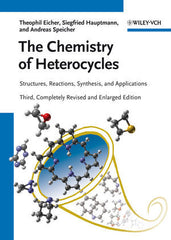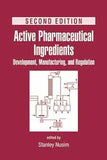The Chemistry of Heterocycles: Structures, Reactions, Synthesis, and Applications 3rd, Completely Revised and Enlarged Edition By Theophil Eicher, Siegfried Hauptmann, Andreas Speicher
The Chemistry of Heterocycles: Structures, Reactions, Synthesis, and Applications 3rd, Completely Revised and Enlarged Edition
This classical textbook in the best sense of the word is now completely revised, updated and with more than 40% new content. The approved ordering system according to the ring size of the heterocycles has been retained, while the important chapter on "Problems and their Solutions" has been almost completely renewed by introduction of up-to-date scientific exercises, resulting in a great tool for self-testing and exams. A chapter on nomenclature and a helpful index of name reactions has also been retained. With approximately 1,000 new literature citations, this book remains a brilliant gateway to modern heterocyclic science for master and graduate students, as well as PhDs and researchers entering the field.
Praise from the reviews (on previous editions):
"If you want quick information about the basic (or acidic!) properties of a heterocycle, some interesting facts, or an assorted few ways of making it, this book provides a welcoming, accurate, and concise introduction." –Angewandte Chemie IE
"Eicher, Speicher and Hauptmann provide an up to date introduction to the field for the advanced undergraduate and graduate students. ... The book is carefully produced to a very high standard." –European Journal of Medicinal Chemistry
Preface to the Third Edition IX
Abbreviations and Symbols XI
1 The Structure of Heterocyclic Compounds 1
Reference 4
2 Systematic Nomenclature of Heterocyclic Compounds 5
2.1 Hantzsch-Widman Nomenclature 6
2.2 Replacement Nomenclature 11
2.3 Examples of Systematic Nomenclature 12
2.4 Important Heterocyclic Systems 15
3 Three-Membered Heterocycles 17
3.1 Oxirane 17
3.2 Thiirane 26
3.3 2H-Azirine 29
3.4 Aziridine 32
3.5 Dioxirane 37
3.6 Oxaziridine 38
3.7 3H-Diazirine 40
3.8 Diaziridine 40
References 41
4 Four-Membered Heterocyles 45
4.1 Oxetane 45
4.2 Thietane 49
4.3 Azete 50
4.4 Azetidine 51
4.5 1,2-Dioxetane 55
4.6 1,2-Dithiete 57
4.7 1,2-Dihydro-1,2-diazete 58
4.8 1,2-Diazetidine 58
References 59
5 Five-Membered Heterocycles 61
5.1 Furan 61
5.2 Benzo[b]furan 80
5.3 Isobenzofuran 84
5.4 Dibenzofuran 86
5.5 Tetrahydrofuran 87
5.6 Thiophene 90
5.7 Benzo[b]thiophene 101
5.8 Benzo[c]thiophene 104
5.9 2,5-Dihydrothiophene 105
5.10 Thiolane 106
5.11 Selenophene 107
5.12 Pyrrole 108
5.13 Indole 125
5.14 Carbazole 148
5.15 Isoindole 150
5.16 Indolizine 152
5.17 Pyrrolidine 157
5.18 Phosphole 161
5.19 1,3-Dioxolane 162
5.20 1,2-Dithiole 163
5.21 1,2-Dithiolane 164
5.22 1,3-Dithiole 165
5.23 1,3-Dithiolane 165
5.24 Oxazole 166
5.25 Benzoxazole 177
5.26 4,5-Dihydrooxazole 181
5.27 Isoxazole 185
5.28 4,5-Dihydroisoxazole 193
5.29 2,3-Dihydroisoxazole 198
5.30 Thiazole 199
5.31 Benzothiazole 208
5.32 Penam 212
5.33 Isothiazole 214
5.34 Imidazole 217
5.35 Benzimidazole 229
5.36 Imidazolidine 234
5.37 Pyrazole 236
5.38 Indazole 243
5.39 4,5-Dihydropyrazole 246
5.40 Pyrazolidine 249
5.41 1,2,3-, 1,2,4-, 1,3,4-Oxadiazole 249
5.42 1,2,5-Oxadiazole 251
5.43 1,2,3-Thiadiazole 254
5.44 1,2,4-Thiadiazole 256
5.45 1,2,3-Triazole 258
5.46 Benzotriazole 265
5.47 1,2,4-Triazole 268
5.48 Tetrazole 273
References 280
6 Six-Membered Heterocycles 297
6.1 Pyrylium Ion 297
6.2 2H-Pyran 305
6.3 2H-Pyran-2-one 306
6.4 3,4-Dihydro-2H-pyran 313
6.5 Tetrahydropyran 317
6.6 2H-Chromene 319
6.7 2H-Chromen-2-one 321
6.8 1-Benzopyrylium Ion 327
6.9 4H-Pyran 329
6.10 4H-Pyran-4-one 331
6.11 4H-Chromene 335
6.12 4H-Chromen-4-one 336
6.13 Chroman 341
6.14 Pyridine 345
6.15 Pyridones 381
6.16 Quinoline 386
6.17 Isoquinoline 406
6.18 Quinolizinium Ion 420
6.19 Dibenzopyridines 423
6.20 Piperidine 429
6.21 Phosphabenzene 434
6.22 1,4-Dioxin, 1,4-Dithiin, 1,4-Oxathiin 438
6.23 1,4-Dioxane 440
6.24 Oxazines 442
6.25 Morpholine 447
6.26 1,3-Dioxane 449
6.27 1,3-Dithiane 453
6.28 Cepham 455
6.29 Pyridazine 458
6.30 Pyrimidine 463
6.31 Purine 474
6.32 Pyrazine 481
6.33 Piperazine 486
6.34 Pteridine 487
6.35 Benzodiazines 491
6.36 1,2,3-Triazine 501
6.37 1,2,4-Triazine 504
6.38 1,3,5-Triazine 508
6.39 1,2,4,5-Tetrazine 512
References 517
7 Seven-Membered Heterocycles 529
7.1 Oxepin 529
7.2 Thiepin 532
7.3 Azepine 533
7.4 Diazepines 540
References 545
8 Larger Ring Heterocycles 547
8.1 Azocine 547
8.2 Heteronines and Larger-Membered Heterocycles 549
8.3 Tetrapyrroles 551
References 558
9 Problems and Their Solutions 561
References 614
Indices 621
Siegfried Hauptmann was born in 1931 and studied chemistry at the University of Leipzig. In 1958, he obtained his Ph.D. under W. Treibs and habilitated in the field of organic chemistry in 1961 and became Assistant Professor and later Full Professor at the University of Leipzig. His research interests lie predominantly in the field of synthetic organic chemistry and reaction mechanisms. Professor Hauptmann is author and co-author of several books.
Andreas Speicher, born in 1963, studied chemistry at the University of the Saarland, Saarbrücken, and made his Ph.D. in 1994 under Professor Eicher in Saarbrücken. He was awarded the Eduard-Martin-Preis of his University for his Ph.D. thesis. He is now an academic representative for organic chemistry of the University of the Saarland, and has co-authored books. Amoungst his research interests are synthesis and characterization of chemically and biologically relevant natural products and macrocycles.


















